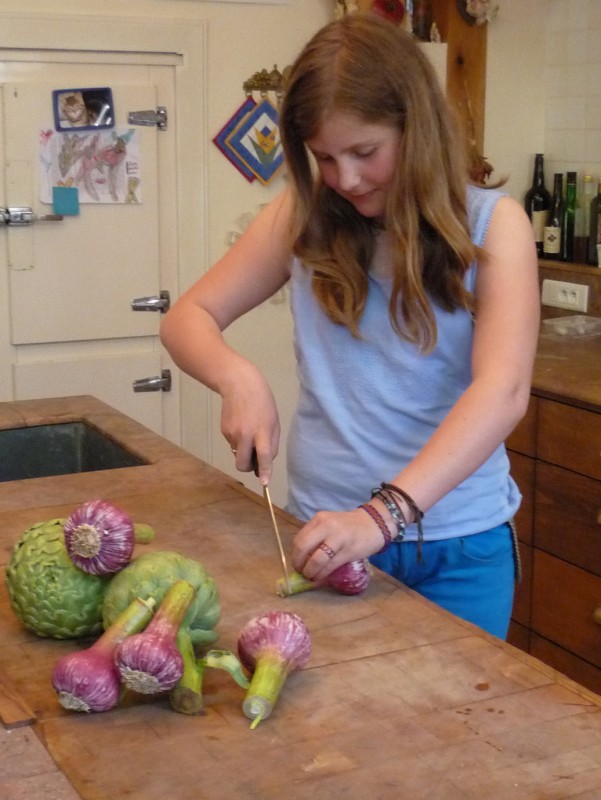Of Garlic and Gardens

Today is brilliant. The sun is shining, and flowers are blooming with auditory splendor—if I were to listen carefully, I am certain I would hear their petals opening.
Out my office window, a pale golden light sifts down over the cathedral like fairy dust. It’s a timid light, not quite used to its own, mid-spring strength. The apple blossoms on my trees are all but gone, which means I’m likely to have fruit before anyone else, since the trees on the plains above my town are still in full flower. In fact, on a quick little vacation this week, my daughter and I drove through the Pays d’Auge, the heart of Norman apple country, and trees there were still heavily bedecked.
Before I get to cooking, I must describe some oysters that I ate on our sojourn. We were on the Ile de Chausey, one of the Channel Islands and a cousin to both Jersey and Guernsey. Unlike them, though, Chausey is French, and about an hour by boat from Granville on the Normandy coast. It is tiny; a walk around its entire circumference takes a maximum of three hours, and that leaves time for examining the ruins of boats on the shore, sniffing the gorse—which smells like coconut—and walking gingerly on old stone walls to avoid puddles and mud.
Everything is remarkable about Chausey, a car-less, people-less (at least in spring), wild yet tamed French island. When the tide is out, more than 300 small islands are visible around Chausey. When the tide returns, they almost all disappear. Many of those that remain host oyster growers, who tend their briny charges regularly throughout the year.
The island boasts one full-time resident, a fisherman, and thirteen others who live there six months of the year. Those thirteen open the island’s small hotel and restaurants, its café, its guest houses and its épicerie, the grocery store where one can order anything from roast leg of lamb to a whole freshly baked fruit tart. In other words, one can go to Chausey and, between the two decent restaurants and the épicerie, never have to make a meal.
And I didn’t. Instead, I feasted on the island’s oysters. Small the way I like them, tender as a dream, they were redolent of everything I saw outside the restaurant window—slate-blue rippling water, rocky outcroppings crowned by greener than green grasses, clumps of palm trees, kestrels flying low then shooting off into the sky, small stone homes with turquoise shutters.
As I delicately slurped my oysters, neat, my daughter had her own delight with steamed shrimp, one of her favorite foods, and impressive servings of cucumbers and tomatoes in an herbed vinaigrette. Topping all of this was the restaurant’s gorgeous homemade chocolate mousse and a stunning strawberry tart. We were happy.
And I was happy to return home. Though our adventure had lasted just three days, it felt more like three weeks. And my garden had grown as if infused with that much time of water and sun.
If I could make a meal from the garden today, it would be a marvel of tiny, biting greens and flowers. I would eat them all raw, for they are blessed with the tenderness of spring. My salad, then, would include delicately curling pea shoots, miniature nasturtium leaves, a few fleshy nigella buds, tangy sorrel leaves and frothy copper fennel fronds. Swiss chard and beet greens would provide the heart of the salad, along with two varieties of arugula—one spiky, the other round and almost stinging hot. I would dress the salad with a light vinaigrette made with sherry vinegar and hazelnut oil, then serve it sprinkled with pansies, flaming red rose petals, forget-me-nots and arugula flowers.
To go with it? Well, my visit to the neighborhood épicier this afternoon yielded almost as much delight as my garden.
You see April, May, and June are always months when garlic lovers cringe, for last years harvest withers before this year’s harvest is ready. I try to protect myself from the inevitable by purchasing stiff braids of pale pink Ail Rose de Lautrec in late fall. Grown in and around the town of Lautrec, in southwestern France, this garlic carries a Label Rouge, which not only guarantees its quality, but promises the consumer that it will stay fresh and good through May. This year, like most, l’Ail Rose de Lautrec rose to the challenge, but just barely. I filled in a bit with new garlic from Egypt, but like so many things flown in from afar it had no flavor. Now it no longer matters, for soulless days without garlic have ceased to be a threat. To my relief Provence, where everything grows with searing flavor, has come to the rescue with new garlic.
What is new garlic? It is simply the immature bulb, its cloves embryonic and full of young, vibrant flavor. Garlic must grow until the hot days of July to reach full maturity.
I love garlic at this stage, and bought an entire bouquet today. I say “bouquet” because if the bulbs, sold on the end of their purple stalks, were put into a vase they’d look like one. I bought so many because I have a cooking class coming up, and on the menu are a variety of things garlic. But I also bought it because my menu tonight, which I created on the spot, depends on it. To make it, I will peel the cloves and cook them in water with a few fresh, seasonal herbs and a potato. I will then puree the mixture, add a beaten egg white, and serve up the resulting, lusciously delicious froth in espresso cups. It will taste of the pure essence of garlic, and one serving won’t be enough for anyone.
The other part of my menu this evening includes garlic as well, but its star is artichokes. Usually, we get globe artichokes from Brittany and I love them, for they are deep green and pre-salted from the sea air, tender, meaty and absolutely decadent. Those available right now are from Provence, and their leaves are more tightly packed, their color yellow-green, their flavor more intense.
Before I braise the artichokes, I will stick some cloves of new garlic down among the leaves, drizzle them with extra virgin olive oil, and add a few new potatoes and tiny whole onions. Another drizzle of oil when I take them from the pan, a sprinkling of fleur de sel, and dinner will be served.
There is no meat, no fish, nothing but these very special spring offerings. Instead, a nice, fresh white goat cheese will follow, and after that only one thing will do—long, thin, sweet and just slightly tart gariguette strawberries. I don’t serve them with cream, preferring instead a sifting of vanilla sugar, nothing more.
NEW GARLIC SOUP/Soupe à l’ail nouveau
4 generous servings; 6 appetizer servings
3 large or 4 medium heads new garlic, cloves separated and peeled
1/2 tsp fine sea salt
2-1/2 cups (625 ml) filtered water
One 4-inch (10 cm) length fresh rosemary
1 medium (6 oz,180 g) starchy potato, peeled and cut in small cubes
1 large egg, separated
Chervil, for garnish
1.Place the garlic cloves, salt, water, rosemary, and potato in a medium-sized saucepan and bring to a boil over medium-high heat. Reduce heat to about medium-low, so the water is simmering, and cook until the potato is tender and garlic is soft through, about 30 min. Remove rosemary, purée soup and taste for seasoning.
2.Whisk egg white until it is frothy and soft peaks are about to form.
3. Return soup to the stove and bring it just to the boiling point. Whisk in the egg yolk until it is thoroughly combined and the soup is slightly thickened, then whisk in the egg white until it is combined and the soup is frothy. Remove from heat and divide evenly among four shallow soup bowls. Garnish with chervil, and serve.
Susan Herrmann Loomis has lived in France for 20 years and currently teaches cooking classes in Normandy and Paris. She has written nine books, including Cooking at Home on Rue Tatin (William Morrow, 2006). Susan’s website
Originally published in the June 2009 issue of France Today.
Share to: Facebook Twitter LinkedIn Email
Leave a reply
Your email address will not be published. Required fields are marked *



